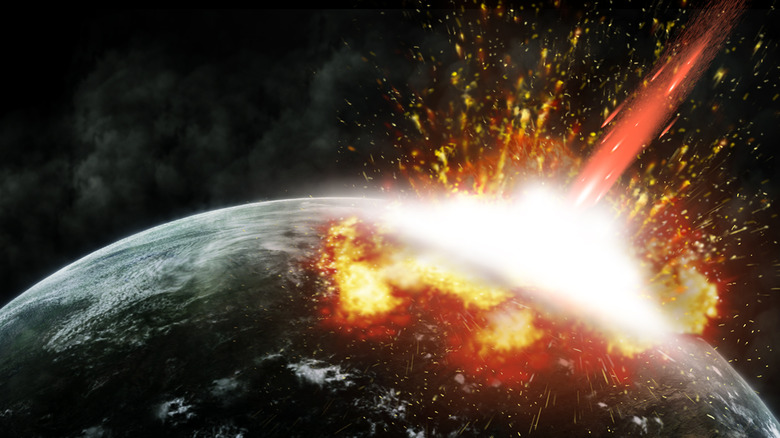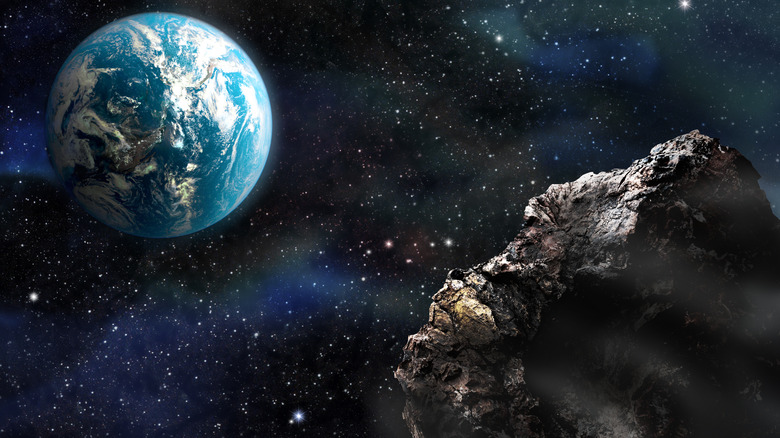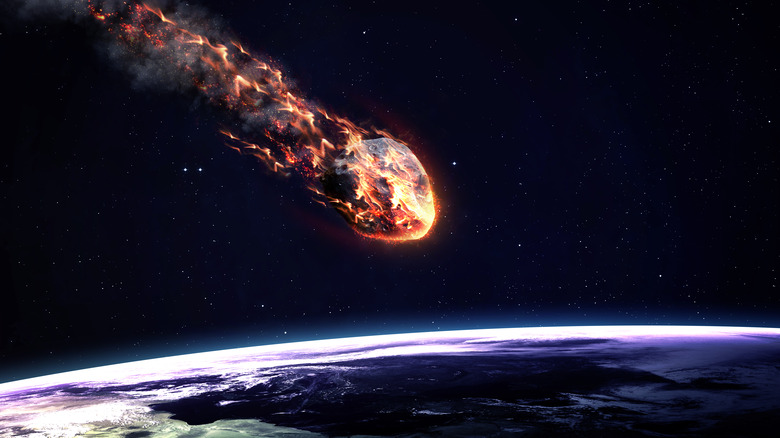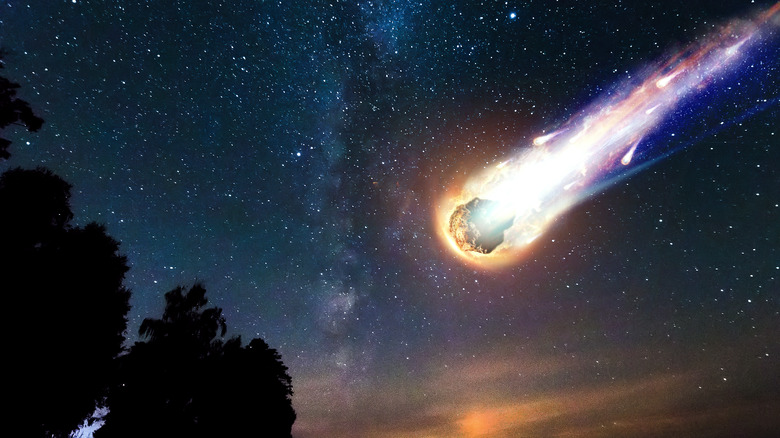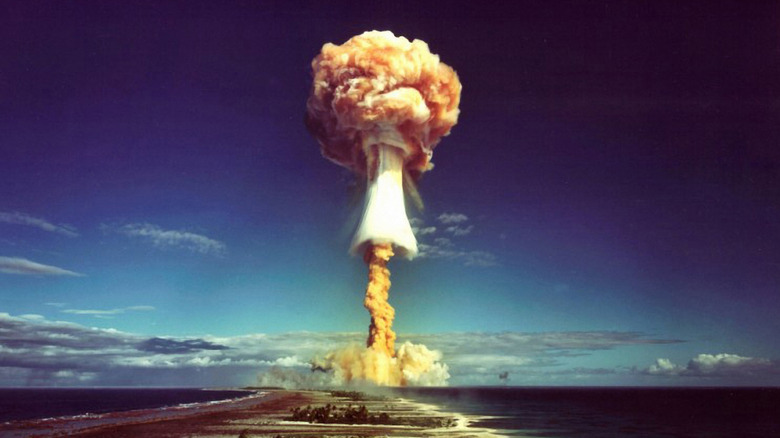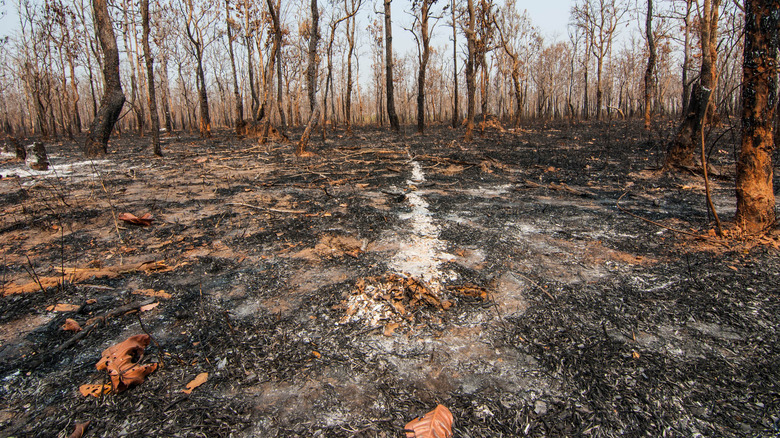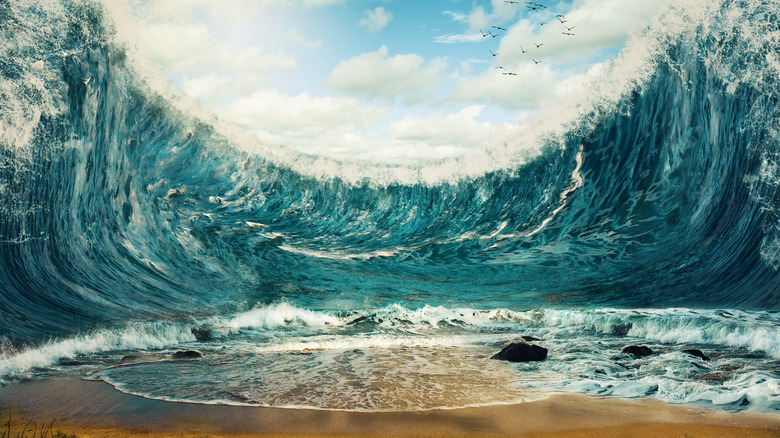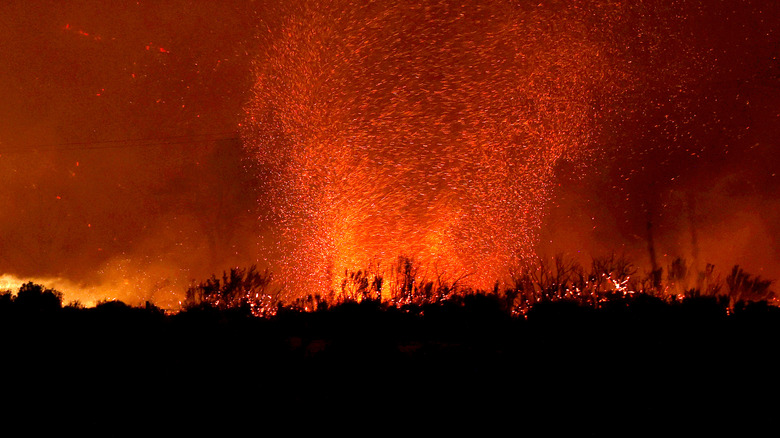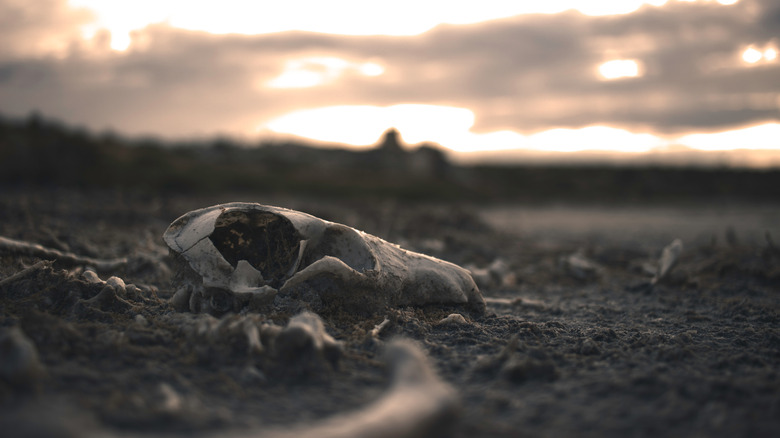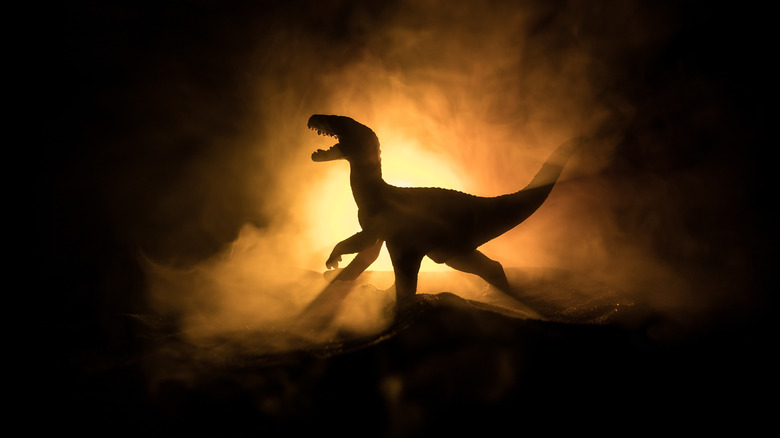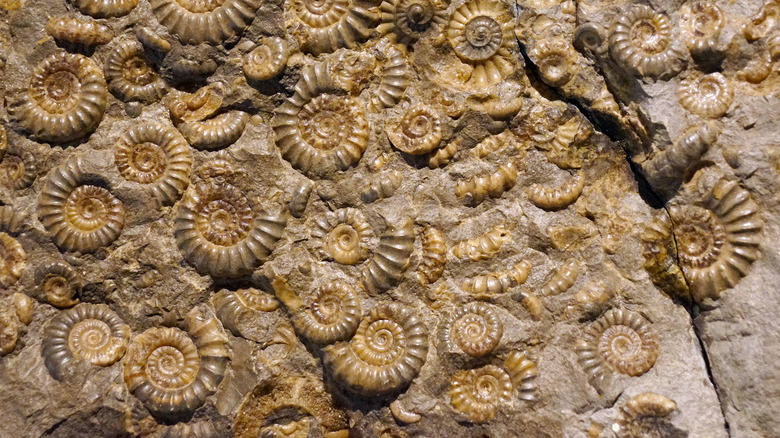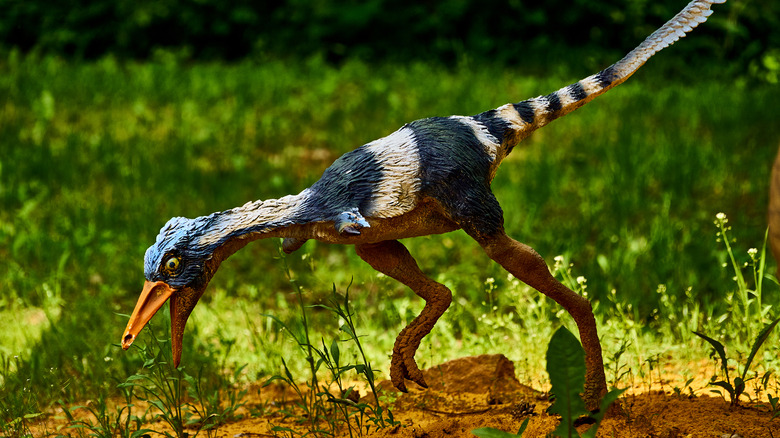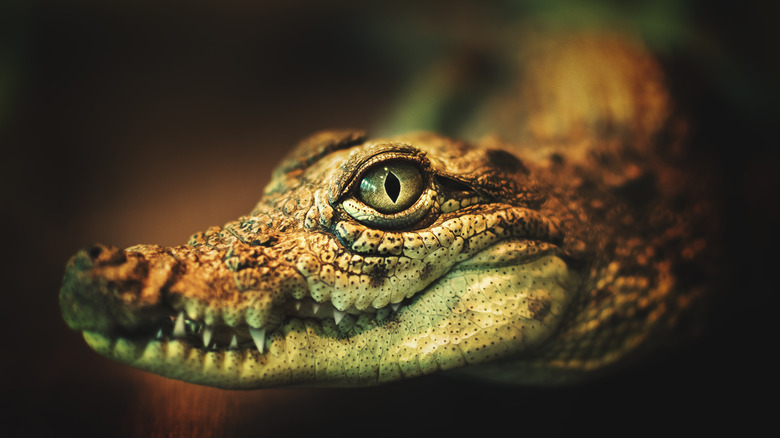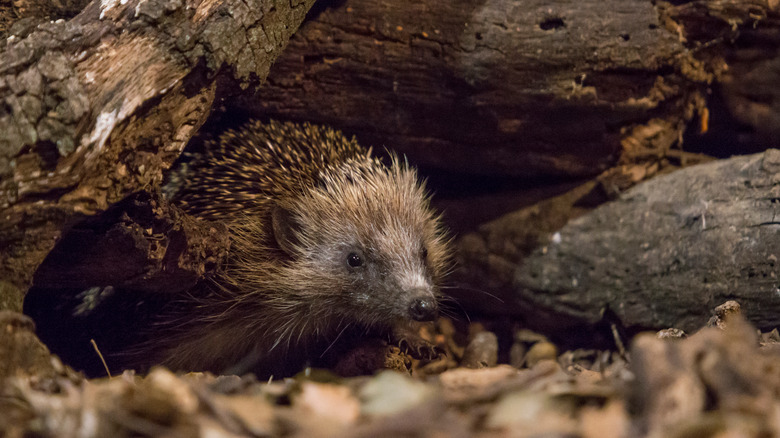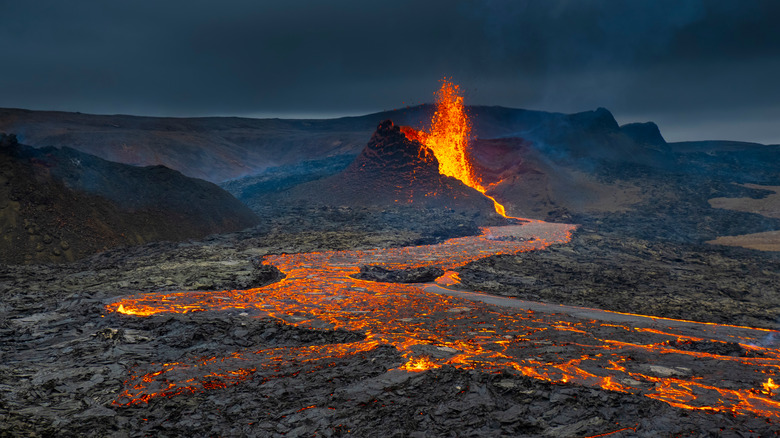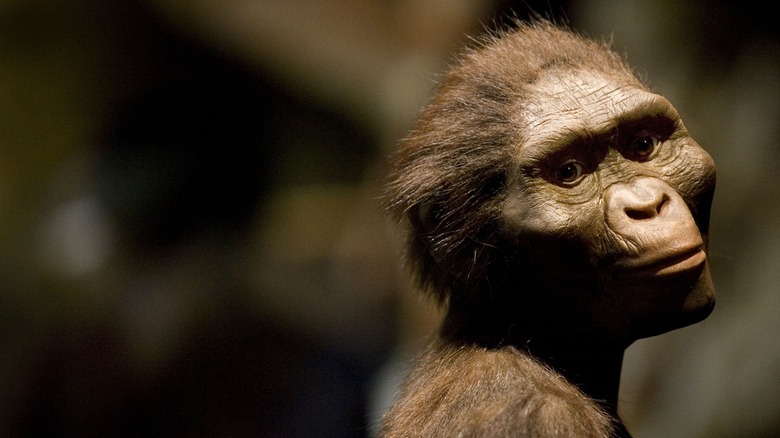The Tragic Truth About The Cretaceous Mass Extinction
From every toddler to school kid and beyond, everyone knows that the dinosaurs were killed by an asteroid, or something similar (scientists just call it an "impactor"). Not everyone knows exactly what that looked like, though. Did the impactor ignite a volcano? Did it break a mountain range in half? Did it hit them all in the heads?
The truth about the Chicxulub impact that set off the Cretaceous mass extinction — popularly referred to as the KT extinction after "Kreide," the German word for "chalk" and "Tertiary," a name for the time period between the Paleogene and Neogene (via Britannica) — is that it was much, much worse than you probably imagined. In most people's heads, a large asteroid or comet is something you don't really want to be under when it strikes, but if you're a couple of hundred miles away, you should mostly be okay.
Unfortunately, though, that's just not true. There really was no safe place to hide from the Chicxulub impactor. The devastation was more than just something falling fast and hard from the sky. The aftermath of the disaster was felt all over the planet, and it lasted much longer than just the hours after impactor and Earth had their formal introductions. Here's the awful, awful truth about the mass extinction event at the end of the Cretaceous.
The impactor was 7.5 miles wide
Seven and a half miles ... meh. You might have hiked that far in less than a day. In fact the Chicxulub impactor was just a little bigger than the island of Ovalau in Fiji (via Ancient Origins), which you've never actually heard of because it's just not that big. Compared to the size of the whole planet — which is about 25,000 miles all the way around — the Chicxulub impactor was a mere pebble. So why did it do so much damage?
The impactor may have been a mere 7.5 miles wide, but it left a 120 mile wide crater. According to National Geographic, it was traveling at 45,000 miles per hour when it struck just off the coast of the Yucatan Peninsula in Mexico. That means it was moving at around 10 times the speed of an X-15 aircraft, which set an unofficial speed record in 1967 (via NASA). Of course, the Chicxulub impactor also weighed roughly 2.27 billion times what the Conversation says a fueled-up X-15 weighs, so it's not like it's an especially fair comparison.
The angle of the strike was perfect for maximum destruction
The impactor was huge, but that's not the only thing it had going for it. According to a study published in the journal Nature, it was also on exactly the right trajectory to cause the maximum amount of destruction.
The authors of the study ran some computer models and used them to determine that the impactor hit Earth at a 45 to 60 degree angle. At first, this seems kind of like a so-what detail, but it's actually a pretty significant number.
The angle at which an impactor strikes the planet can affect the resulting debris — its type, quantity, volume, and trajectory. An impactor that strikes the Earth at a 45 to 60 degree angle produces a nearly perfect circle of equally distributed debris, and much more greenhouse gas than an impactor that strikes the planet at a shallower angle. So this is really what doomed the dinosaurs — if the strike had been from straight above or at a 20 degree angle, those on the other side of the planet might have been okay. But the strike angle pretty much guaranteed that the whole planet would suffer in the aftermath, not just those close to the impact.
It might have been a comet
In 2021, Harvard University researchers hypothesized that the Chicxulub impactor wasn't an asteroid at all, but a fragment of a comet. According to the study, published in Nature, the impactor was a carbonaceous chondrite, which is an object that contains about 5% carbon.
Most asteroids aren't carbonaceous chondrites; instead, they're composed of silicates, nickel, and iron, or some combination thereof. It may be more common for a comet to have a carbonaceous chondrites composition, but the odds of a comet large enough to cause a Chicxulub sized crater crossing Earth's path were previously thought to be too remote to make such an impact possible.
The Harvard scientists begged to differ. They think comets passing too close to the sun could be broken into smaller bits that might potentially intersect with the earth's orbit. If that's true, the sky must have looked pretty spectacular in the days and weeks before most of the planet's life was snuffed out. Apparently, there really is a silver lining in every comet.
The impact created a ridiculous amount of force
If you grew up in the '80s, you probably remember the nuclear bomb drills. The sirens would go off, and everyone was supposed to crawl under their desks, as if that 2-by-2-foot piece of wood sitting on its flimsy metal frame would protect you from a 1 megaton nuclear explosion.
Nuclear bombs carry a lot of force. According to MIT, The force of an explosion is measured in either kilotons or megatons — a kiloton is the equivalent of 1,000 tons of TNT, while a megaton is the equivalent of a million tons of TNT. The biggest bomb ever detonated was 5 megatons, so that's pretty huge. And if you want to go even bigger, you could combine the nuclear arsenals of America and Russia and explode them all at the same time, and that would be the equivalent of 14,000,000,000 (14 billion) tons of TNT.
Now we've reached the limits of the explosions human technology is currently capable of. Let's compare that to the force of the Chicxulub impactor. When the asteroid or comet or whatever it was hit the Earth, it had the explosive force of 100,000,000 megatons, which is the equivalent 100,000,000,000,000 (100 trillion) tons of TNT. That ... is a lot of zeroes.
The death zone extended hundreds of miles
If you grew up in the 80s, you also spent a lot of time wondering if you'd survive a nuclear attack, and then you found out that it doesn't really matter, because the fallout would kill you anyway. This is why Gen X's brand is indifference.
Anyway, according to Science Alert, survivability of a nuclear attack depends on a lot of things, like how far you are from the hit, what the weather is like, if there are any mountains between you and the explosion, and, obviously, how big the bomb is. But for the most part, the farther away you are, the better. At roughly 7 miles from a 1 megaton nuclear bomb strike, you can expect to get a nasty sunburn, but you won't die. At least not right away.
If you were just seven miles from the Chicxulub impactor, well, let's just say that was far enough away that you'd get to experience instantaneous death, thus saving yourself from the years of suffering that would follow. What if you were 500 miles away? Instant death. Because the impact created a wall of rock and debris roughly 20 miles high and generated a fireball traveling at about 1,000 miles per hour (via Wired). In fact, according to National Geographic, everything within about 625 miles of the impact died instantly. To put that into perspective, that's roughly the straight line distance between Phoenix and San Francisco (via Distance.to).
It caused a huge tsunami
The Chicxulub impactor did not strike dry land. It hit the sea, and let's just say that the water didn't exactly cushion the blow or anything. To be fair though, even 66 million years ago the waters in what is now the Gulf of Mexico weren't super deep, which gave the impactor an opportunity to instantaneously create both land and ocean-based catastrophe. According to Eos, the impact created a 4,900-foot tsunami (in case you're not great at visualizing distance, that's only a few hundred feet short of a mile). And that was just the opening act. A giant sucking sound ensued, followed by more tsunamis, which spread out across the Pacific Ocean. These waves weren't nearly as big as the first (only around 46 feet or so) but they got bigger as they cruised along the ocean towards land, and it's a safe bet that they wiped out coastlines all over the world.
The impact fundamentally changed the geology of the nearby landscape, too. According to a 2021 study published in Earth and Planetary Science Letters (via LiveScience), the rushing water traveled all the way to what is now Louisiana, where it left 52-foot "megaripples" — similar to the ripples waves leave in sand, only much, much bigger — on the seafloor. Today, the megaripples are still visible on seismic images of the subterranean landscape.
There was a rain of molten rock
So far, the Chicxulub impact sounds very, very bad. Couldn't get much worse. Except that it did. Because after the impactor hit the Earth it thought to itself, "Let's see, what destruction have I brought down upon this planet so far? Lethal impact force, check. Wall of rock, check. Tsunamis, check. Massive fireball, check. I know! How about molten rock raining down from the sky?
According to New Scientist, the force of the impact was powerful enough to vaporize rock, and what happens to stuff that gets turned into hot vapor? It rises. And then what happens after that? It falls down again. So a few hours after the impact everything that was lucky enough to avoid the impact itself and the fireball and the tsunamis had to contend with molten rock falling from the sky. Which obviously killed even more animals and ignited wildfires that basically burned down the entire planet.
And there's more — acid rain (via NASA), 24-hour darkness that lasted for years, an ecosystem-destroying overnight surface temperature drop of 82 degrees (via a study published in the Proceedings of the National Academy of Sciences) — it's actually pretty shocking that anything could survive that kind of devastation, let alone manage to eventually repopulate the utterly devastated planet that was left behind.
Roughly 80 percent of all animal species died
It's difficult to even comprehend how devastating the Chicxulub extinction was. According to Britannica, 80% of all the world's species were lost, and that includes everything from microcellular life all the way up to the biggest dinosaur. The impact and its aftermath killed all the non-avian dinosaurs and, according to Science, all the larger mammals and half of the world's plant species. Invertebrates were hit hard, too — in the ocean, around 75% of them disappeared (via Wright State University).
Imagine this kind of devastation happening today — not only could you expect to lose most of the people you know, but half of all the plant life you've ever seen and every fuzzy creature weighing more than a pound and a half. This includes, in all likelihood, your dog. Unless you like chihuahuas.
Despite all the senseless death, the impactor didn't kill indiscriminately. It killed off certain kinds of animals, and it spared certain other animals. As it turns out, some species were uniquely adapted to survive the devastation, though it's probably safe to say those adaptations were compatible with cataclysmic destruction totally by accident. Evolution doesn't tend to see disasters coming — on the other hand, pretty much everything about evolution is kind of accidental, so it's not actually that surprising that some species were accidentally primed to survive the unsurvivable.
Then there was all the slow death
So let's say an asteroid strikes the Earth 700 miles from your house. You're barely outside of the instant-death zone, so your first reaction might be, "Whew, I really dodged a giant, planet destroying bullet, didn't I?" Unfortunately, a few weeks in the aftermath might make you wish the asteroid had landed right on your house, because life in a post-apocalyptic landscape is not exactly fun. The days and weeks after the Chicxulub impact were dismal and dangerous — according to NASA, the impactor ejected trillions of tons of dust and debris into the atmosphere, and the wildfires filled the sky with soot and ash. The world became very dark and very cold.
If this happened today, humans could survive for a while by looting abandoned grocery stores — until the motorcycle gangs took over, anyway — but the dinosaurs had no such luxuries.
Things did survive, but most of them didn't hang on for long. Without light, photosynthesis came to a screeching halt (via the New Yorker). Green things everywhere from trees to plankton died, and oxygen levels fell. The food chain fell apart. Any herbivorous dinosaurs that were still around died of starvation. Without any meat to eat, the carnivores died, too. According to paleontologist Ken Lacovara (speaking in the BBC documentary "The Day the Dinosaurs Died," via BBC) it took no more than a few weeks or months for 80% of the world's species to disappear forever.
The event disproportionately killed things with shells
If you had to guess where on planet Earth most creatures would be the most likely to survive, you might think it was the ocean. After all, when you're under water you don't notice things like tidal waves zipping along the surface and you're a lot less affected by things like fire and falling lava. Unfortunately, ocean-dwelling creatures suffered in the aftermath just as much as the land animals did. The impact didn't just cause waves and darkness, it changed the actual chemical composition of the ocean.
In 2019, the authors of a study published in the Proceedings of the National Academy of Sciences measured boron isotopes in the shells of tiny plankton called foraminifera and used the data to conclude that the ocean became a lot more acidic after the Chicxulub impact. That finding is consistent with large amounts of acid rain, which lowered the pH in the ocean and made it difficult for creatures like ammonites and other molluscs to build their shells (via Yale University). As these animals died, the entire oceanic food chain was disrupted, setting off a cascade of death and eventual extinction. The ocean became a quiet place. Only half of the world's marine species survived.
Birds were the only dinosaurs that survived
It's only been in the last 50 years or so that scientists really started to recognize the similarities between birds and dinosaurs (via Natural History Museum). Dinosaurs still live among us — you have only to look a cassowary in the face to know how true that is. The avian dinosaurs lived to become birds, but they were the only branch of dino that had those accidental adaptations that allowed just enough of them to live through the destruction.
Why did avian dinosaurs survive while the rest of them did not? Well, small size was a big factor in the survival of a lot of animals, including birds. According to a study published in Current Biology, the birds that survived weren't the ones that lived in the trees (because remember, the forests mostly burned down), they were the ones that lived on the ground. And they tended to be smaller in size, too, which makes sense because small things have limited energy requirements compared to large things.
Another theory is that seed eaters had an advantage because seeds were tough enough to persist while everything else in the environment perished. According to research published in The Royal Society of Open Science, egg shape may also have contributed, though researchers aren't sure why. One researcher did tell the BBC that birds that incubated their eggs might have had an advantage over the birds that buried their eggs, simply because buried eggs were more vulnerable.
Reptiles didn't do as well as previously thought
Scientists used to believe that the more familiar reptiles like snakes and lizards did mostly okay after the impact, but a 2013 study published in the Proceedings of the National Academy of Sciences found otherwise. Species extinction amongst lizards and snakes might have actually been as high as 83%. Just like with mammals and birds, the smaller the animal, the greater its chances of survival.
Still, some larger species of reptiles like the crocodiles also survived the mass extinction, which is a pretty remarkable feat given that size was so strongly correlated with death. According to a study published in the International Letters of Chemistry, Physics, and Astronomy, being cold blooded may have given these larger reptiles an advantage since cold blooded animals don't have to eat as often as warm blooded animals do and would have been better equipped to avoid starvation (yep, Yale paleontologists have confirmed, at least three of the major dinosaur lineages were warm blooded). Another theory about the oddball survival of crocodiles, according to ThoughtCo: They live near freshwater, and freshwater animals didn't suffer as much as saltwater animals and land-dwellers. This would have benefited not just the crocodiles, but also the freshwater animals that crocodiles feed on.
Mammals survived by hiding
At the barely-habitable edges of the impact zone, the only creatures that survived were the ones that took cover from the devastating heat and the rain of molten rock. Many of these animals were small mammals, rat-like creatures that lived in burrows. Contrary to popular myth, not all mammals that lived during the Cretaceous spent their days in burrows and their nights slinking around on the surface — in fact, according to the University of Washington, mammals were pretty diverse even while living alongside dinosaurs. Besides burrowing mammals, there were also semi-aquatic mammals, flying mammals, and tree-dwelling mammals.
That same myth leads us to believe that all mammals survived the impact, but that's not true. The ones that lived through the destruction and the aftermath were the ones that were uniquely adapted to life in an apocalyptic hellscape. As it turned out, the adaptation that protected some small mammals from predatory dinosaurs also protected them from large chunks of falling debris. According to Science Daily, burrows kept them safe from the initial blast of heat and the rain of molten rock. And because they were small, they could survive by eating small things like insects, and in some cases the plants that were still surviving in freshwater lakes and ponds. So in a way, it was the meek who inherited the devastated planet — and that's how humans ended up at the top of the food chain. Kinda humbling, isn't it?
Dinosaurs were already in decline
In the end, science will never agree about anything. There are still plenty of credible scientists who don't think the KT extinction was entirely impactor-based. They don't deny the Chicxulub impact happened, they just don't think it was the thing that ultimately killed the dinosaurs.
According to New Scientist, dinosaurs were already well on their way out at the time of the impact, in fact, there were only about half as many dinosaurs as there had been 10 million years before. This could have been because of climate change and habitat loss — yes, even 66 million years ago, climate change was a specter of doom. Back then, climate change was probably caused by volcanic activity on the Indian subcontinent.
It's hard to know what would have happened if the Chicxulub impactor hadn't shown up. The decline might have continued, but it's also possible that it wouldn't have, and that dinosaurs would have lasted long enough to keep mammals in their place. With all those big predatory dinosaurs running around, primates might not have evolved, or if they did, they might have spent so much time running for their lives that it never would have occurred to any of them to pick up a spear or light a fire. So you can probably thank Chicxulub for your big brain, your comfortable life, and Netflix. None of that would be possible if dinosaurs still roamed the Earth.
It wasn't the worst major extinction event
Even without big chunks of space debris, Earth has a pretty remarkable capacity for self-destruction. During our planet's long history, there have been five major extinction events, and the other four of them managed to be super-devastating even without the help of a 7.5-mile wide impactor. And by the way, despite the fact that 80% of all species died, the KT extinction wasn't even the worst of the five extinction events. In fact, it only ranks third in terms of total devastation (via Britannica). It's almost like the impactor just wasn't trying hard enough.
Interestingly, extinction in general is a lot more common than survival — according to PBS, over 99.9% of all the animals who have ever lived on the planet are extinct. Most of them died during the five major extinction events, but as everyone knows based on the dumbest line from "Jurassic Park," "life ... uh ... finds a way." After Chicxulub, life rebounded and biodiversity returned. Which is great, except that we're now in the midst of the 6th major extinction event, and we're the ones causing it. In fact, many scientists think by the time it's over we'll have lost around 90% of the world's species, which makes human beings just that little bit more catastrophic than a big chunk of space debris.
